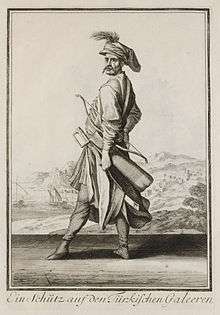Azap
Azabs (Ottoman Turkish: عزب, modern Turkish Azap, from Arabic, literally unmarried, meaning bachelor) also known as Asappes or Asappi, were a kind of peasant militia, originally made up of unmarried youths who served as irregular foot soldiers (light infantry) in the early Ottoman army.[1]

Part of a series on the |
|---|
| Military of the Ottoman Empire |
 |
|
Classical army (1451–1826) Kapıkulu (Janissaries · Six Divisions of Cavalry) · Sipahi · Voynuks Yamaks · Dervendjis · Sekban · Akinji · Azap · Levend · Timariots · Yaya · Humbaracı |
|
Modern army (1861–1922) |
|
|
| Conscription |
The Azaps were also known as "the bachelors", they were volunteers who were paid only during campaigns and had the freedom to leave the army whenever they wanted. The Azaps were initially only Anatolian Turks, though by the late 16th century any Muslim from an Ottoman province could enlist as an Azap. The main role of Azaps was fighting as infantry archers, although they were often mounted as well. In addition to jobs in the military many also had jobs as guards.
As volunteers the Azaps had a wide range of weaponry. These include pole arms, such as the tirpan and harba as well as balta (halberd). In addition to pole arms they were armed with a variety of maces, bows, sabers and to a rarer extent crossbows. Later on guns were adopted instead.
Reforms
The power and significance of the Azaps began to deteriorate as time went on. Despite once seen as rivals to the elite Janissary Ocak, by the 16th they were responsible for taking on smaller tasks such as carrying ammunition and sapping the enemy walls.
In the late 16th century all Muslim men could enlist. From every 20-30 households 1 man would join whilst the others supported him. The standard weaponry of an Azap of this era was a matchlock and a sabre.
References
- Áoston, Gábor; Masters, Bruce Alan (21 May 2010). Encyclopedia of the Ottoman Empire. Infobase Publishing. p. 616. ISBN 978-1-4381-1025-7.